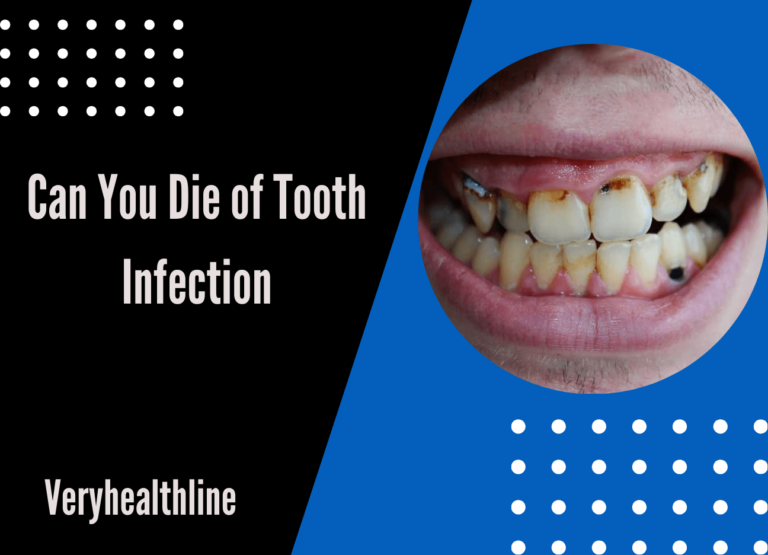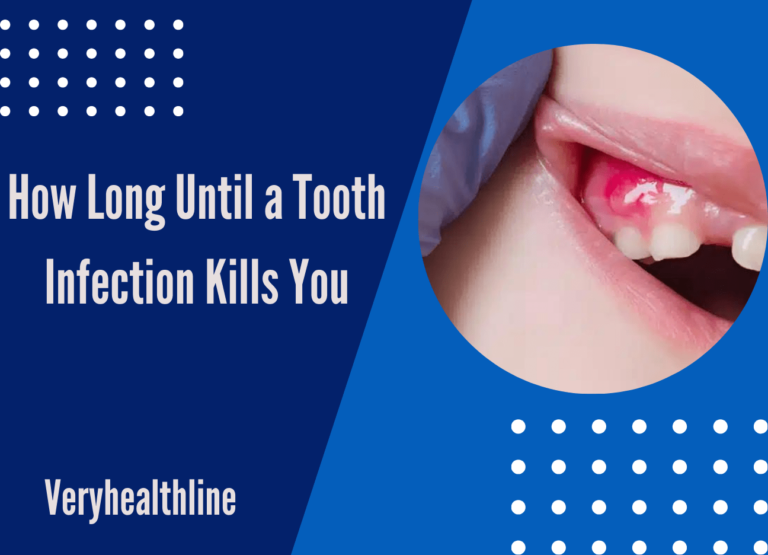What Does a Tooth Implant Look Like: A Comprehensive Guide
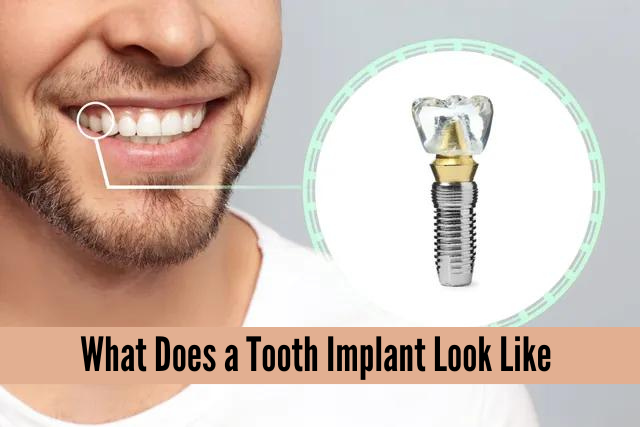
Tooth implants stand out among dental restorations as an attractive and long-term solution to replace missing teeth. What exactly does a tooth implant look like?. This blog post hopes to demystify tooth implants and accurately represent their process, from initial consultation to final outcome.
Understanding Tooth Implants
Front tooth implants have three main components. An implant is a small titanium post surgically implanted into the jawbone to serve as an artificial tooth root.
An abutment connects to this implant and holds up the crown. A crown, mimicking the appearance and functionality of natural teeth, is a customized artificial tooth that closely resembles its counterparts.
Front tooth implants differ from other dental implants because they require careful consideration of aesthetics, bite, and speech.
Since front teeth are visible when smiling or speaking, they must blend seamlessly with surrounding teeth. Furthermore, proper alignment of front teeth is essential to chewing efficiently and maintaining overall oral health; front tooth implants must not interfere with speech.
Visual Characteristics of Tooth Implants
The Implant Post: The implant post is not visible once the surgical site has healed and integrated with the jawbone. Made of titanium, a material biocompatible with the human body, it ensures the durability and success of the implant.
The Abutment: In most cases, the abutment is also invisible once the crown is placed over it. Exceptions might occur if the gum recedes over time, revealing a small part of the metal abutment near the gum line.
However, advancements in abutment materials, like ceramic, can minimize visibility and provide a more natural appearance.
The Crown: The crown is the only part of the tooth implant that is meant to be seen. Thanks to modern dental technology, the crowns are exquisitely crafted to resemble natural teeth closely.
The porcelain used in making crowns can be shaded to match the color of your surrounding teeth, ensuring that the implant looks no different from your natural teeth. When you smile, speak, or eat, others see a restoration that blends seamlessly with the rest of your teeth.
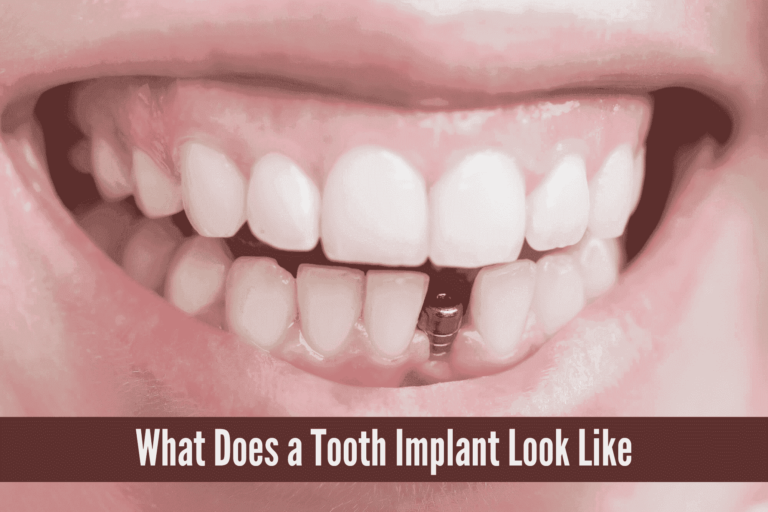
Front Tooth Implant Procedure: What You Should Know
The process for front tooth implants often involves multiple steps and may take months. Following an initial consultation and examination with your dentist, they will determine whether you are a suitable candidate for this procedure. This may include taking X-rays or 3D scans of your mouth to assess its structure, surrounding teeth, and jawbone condition.
Next comes surgical implant placement into the jawbone, which may require local anesthesia or sedation. Osseointegration occurs over several weeks to months as the implant fuses with its host bone.
Once an implant has become fully integrated with your jawbone, an abutment is attached, followed by a custom-made crown that ensures proper fit and alignment with its respective abutment. Your dentist will make sure everything fits correctly before permanently fastening it to the jawbone.
What Does a Tooth Implant Look Like?
A tooth implant typically looks very similar to a natural tooth, making it difficult to distinguish between the two. The crown’s color, shape, and size can be customized to match the patient’s natural teeth, ensuring a seamless blend with their existing smile. Additionally, the implant is placed beneath the gum line, making it virtually invisible from the outside.
Benefits of Tooth Implants
In addition to their natural appearance, tooth implants offer many benefits:
- Improved Function: Unlike traditional dentures, tooth implants are securely anchored into the jawbone, allowing for improved chewing and speaking abilities.
- Long-Term Solution: With proper care, tooth implants can last a lifetime, making them a cost-effective solution in the long run.
- Preserve Jawbone: When a tooth is missing, the jawbone can deteriorate. A tooth implant helps to stimulate the jawbone, preventing bone loss and maintaining the structure of the face.
Types of Dental Implants
- Single Tooth Implant: Replaces a single missing tooth.
- Includes one fixture, abutment, and crown.
- Multiple Tooth Implant: A dental bridge supported by implants can be used for multiple missing teeth.
- Complete Mouth Implant (All-on-4 or All-on-6): Used to replace an entire arch of teeth.
- A set of implants supports a full-arch prosthesis.
What does a front tooth implant look like
A front tooth implant is a dental prosthesis designed to replace a missing or damaged tooth in the front of the mouth. Unlike other types of dental implants, which may be placed anywhere along the jawline, front tooth implants are specifically designed for use where the upper and lower teeth meet.
Front tooth implants typically comprise three components: the implant itself, the abutment, and the crown. The implant is a small titanium post that is surgically placed into the jawbone, replacing the root of the missing tooth. Over time, this post fuses with the surrounding bone in an osseointegration process, providing a solid foundation for the replacement.
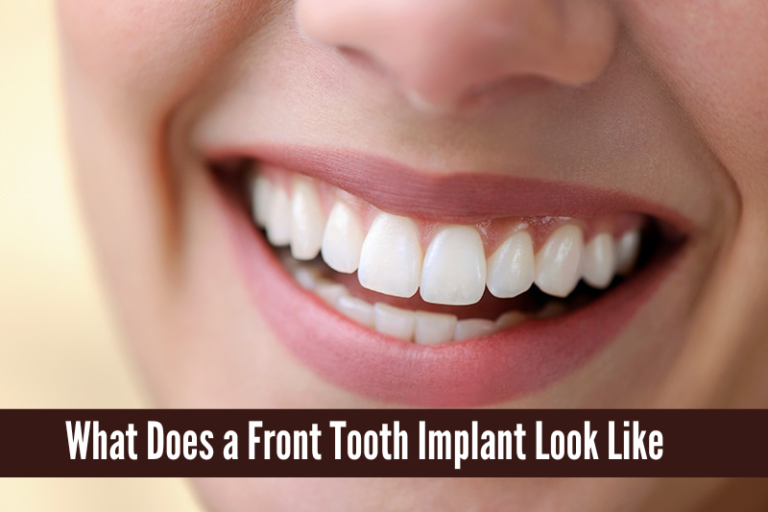
what does a failed tooth implant look like
Dental implant failure usually presents as a loose implant that moves or shifts quickly, often accompanied by discomfort when chewing or applying pressure. Visual signs of infection could include redness, swelling, or pus in the gum area surrounding it.
Sometimes, gum tissue might recede from around it, exposing parts of its metal abutment. Persistent bad taste or foul odor could also indicate failure.
Reasons for a Front Tooth Implant
Opting for a front tooth implant can be motivated by several compelling reasons, primarily related to aesthetic, functional, and health-related aspects.
Aesthetic Appeal
The front teeth are apparent and significantly affect one’s smile and overall facial appearance. An implant in this area helps to restore a natural and pleasing look, boosting confidence and self-esteem.
Functional Benefits
Losing a front tooth can impair your ability to bite and chew properly. A front tooth implant restores full functionality, allowing you to eat a wider variety of foods without difficulty.
Oral Health Preservation
Leaving a gap where a tooth has been lost can lead to bone loss in the jaw and the shifting of adjacent teeth, potentially disturbing the natural alignment of your bite. A tooth implant helps to prevent these issues by simulating the root of a tooth, thereby maintaining jawbone density and supporting facial structure.
Longevity and Durability
Front tooth implants offer a durable and long-term solution to tooth loss. Unlike bridges or dentures that might need regular replacement, implants can last a lifetime with proper care and maintenance, making them a cost-effective choice.
Implementing a front tooth implant not only enhances the visual harmony of your smile but also serves to protect and sustain oral health, proving to be a valuable investment for those who have experienced the loss of a front tooth.
How Is A Front Tooth Implant Placed?
Setting up a front tooth implant requires careful consideration and often multiple steps. First, the dentist will comprehensively examine a patient’s oral health, including X-rays or CT scans, to assess their jawbone health and surrounding teeth condition. If suitable candidates for implants exist, surgery will then commence.
During surgery, a dentist makes a small incision in the gum to expose the jawbone, where an implant will be installed. With the assistance of special tools, a hole is then carefully drilled into the bone before inserting a titanium implant post into it. Sometimes, temporary teeth can be placed over this site to enhance its aesthetics while it heals.
After implant placement, several months must pass for complete osseointegration to occur – this timeframe allows the implant to fuse with jawbone tissue and create a firm and secure foundation for new tooth(s).
The Installation Process
The process of getting a tooth implant involves several stages, including:
- Consultation and Planning: Your dentist will assess your oral health, take X-rays, and perhaps do a 3D scan to plan the implant placement.
- Implant Surgery: The implant post is surgically placed into the jawbone. This requires a period of healing that can last several months.
- Abutment Placement: Once healed, the abutment is attached to the implant post.
- Crown Fitting: Finally, the custom-made crown is fitted and attached to the abutment, completing the look of your new tooth.
The Final Look and Feel
An implant looks and functions similarly to natural teeth. Its crown’s color and shape will blend in seamlessly with other teeth in your smile. Being secured within your jawbone means it feels part of you, enabling you to eat, talk, and smile without fear that something might shift or fall out.
Conclusion
Tooth implants offer a long-term solution for tooth loss with a natural appearance and functionality. Through careful planning and customization, dental professionals can achieve virtually indistinguishable results from natural teeth. If you’re seeking a solution that looks and feels natural, tooth implants could be the answer you’ve been searching for.
Considering a tooth implant is a significant decision, and being informed is critical. Hopefully, this overview sheds light on what a tooth implant looks like and helps you feel more comfortable and confident with the implant process. Always consult with a dental professional to discuss your specific needs and expectations.

